2017 Northern Flicker Nesting
Flickers successfully raised a brood in June of 2017, after failing in 2015 and 2016 due to intense starling pressure at all four of the barn mounted boxes. This year starling pairs began to build nests in the 3 available boxes, as usual. Boxes were monitored frequently and starlings were trapped and nesting material promptly removed. The flickers frequently entered these boxes, but were soon driven off by yet another pair of starlings. Only box “A”, chosen by the kestrel pair went uncontested by starlings. It had housed a family of squirrels who vacated in early April. The box did not have video monitoring then, so I missed any interaction between the squirrels and kestrels.
After being driven from the barn mounted boxes many times, the male flicker finally resorted to the old post mounted box in the barn yard. Flickers had not nested in this box since 2005. Starlings had also ignored this box. It seems that nothing attracts starlings to a nest box more than the presence of a flicker. But, the starlings had already lost interest in nesting in early June, when the flickers were observed at the barn yard box. Once again, the flickers succeeded in nesting only after the starlings moved on. I know of no other bird that has to work longer and harder to secure a nest site than a flicker in a starling infested area. And, where snags are readily available, the flicker likely creates more cavities for starlings than do other woodpecker species. They sometimes excavate several in one season, with the starlings perching nearby and waiting.
This winter ( Jan, 2018) the flicker family has remained together. The male is spending each night in the kestrel box (box A), and one of this year’s brood of four is continually finding its way into the barn, requiring that I check the 2nd floor every day and open a high window for it to escape. I have not found where it is entering. The female seems to be frequently spending the night in box C and the others under the eaves. The male kestrel also checks box “A” every few days, but has not yet encountered the male flicker. No squirrel has entered box “A” this winter. That is the only box being monitored with motion detection.
|
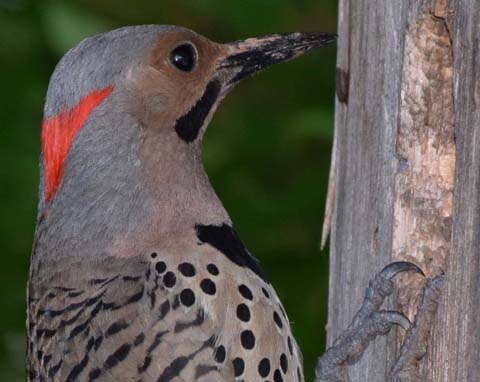
The male flicker

The female flicker
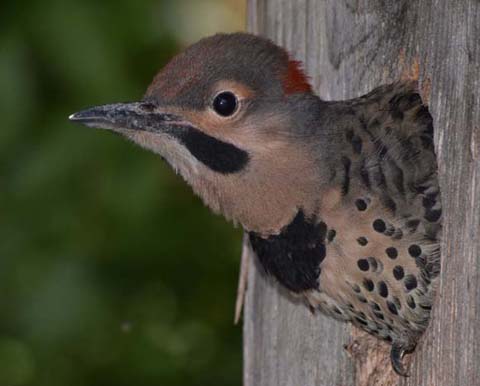
A nestling
|
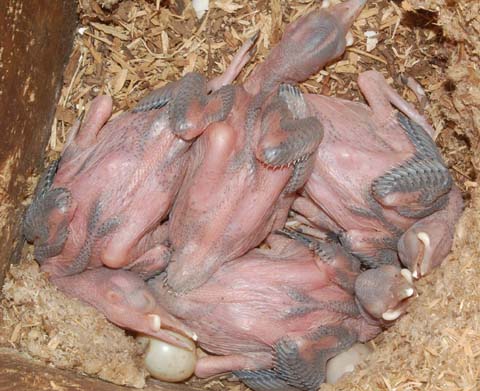
|
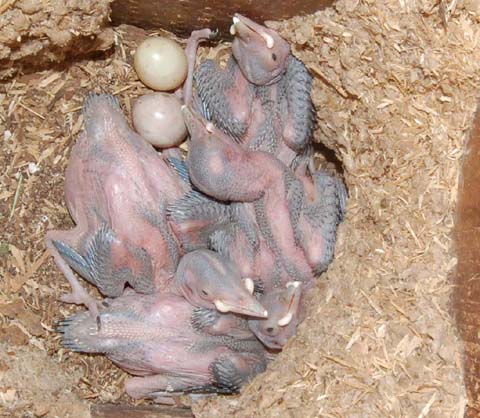
|
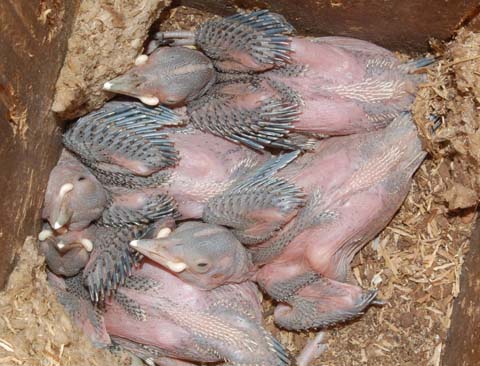
|

|

|
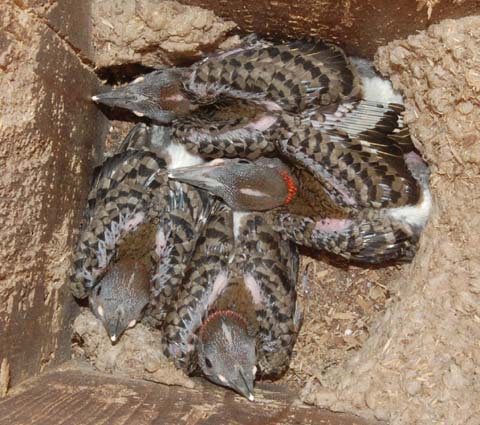
|

|
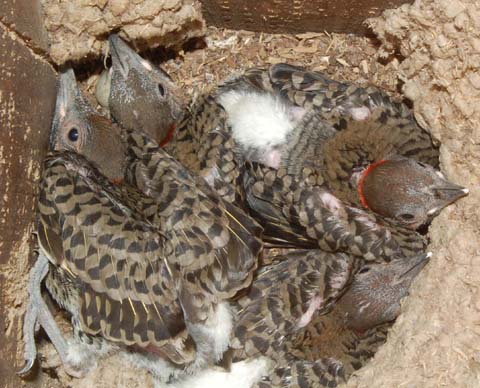
|

|
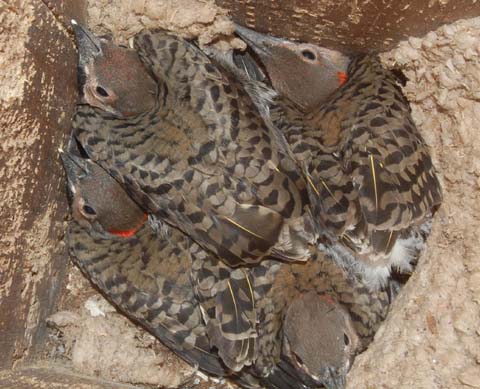
|

|

|
2018 flicker nestings
2018 witnessed black rat snake predation on flicker nestlings in box A, followed by predation on the flickers’ second set of eggs in box C. See 2018 flicker predation for the shocking adventures of that year. |
2019 – There were no flickers nesting in any boxes. However flickers did successfully nest across the creek in a large snag. In the fall and winter several flickers roosted nightly under the barn eaves. These were likely the family from the creek nesting.
2020 – Again there was success in the snag across the creek, but not in any of the boxes. Protect those snags! Many of ours along the creek were broken off this year in both wind and floods.
|
2021 A male flicker frequently visited all three open barn boxes but could not compete with starlings and kestrels. Finally on May 21, a pair of flickers were observed visiting the (very) old flicker box in the barnyard. This box had first been used by flickers in 2002 and again in 2005 and 2017. Earlier this spring a pair of squirrel pups were reared in the box, making a subsequent flicker nesting worrisome. But, nothing, including the squirrels, black rat snakes and starlings interfered with a successful flicker nesting this time!
Click on the links below to listen to the loud chatter of the nestlings as it evolves with age. |
|
| Young nestlings display a brilliant white upper and lower egg tooth as well as light flanges which frame their open gape in the darkened nesting cavity. These videos were taken with a bright light, making the effect less noticeable. Their loud vocalization whenever the nest hole is darkened by the arrival of an adult or even the passing of my hand over the hole may serve to frighten potential predators. |
|
| Three days later, their energy seems to have increased. |
| |
| Two days older still, their loud and low pitched buzzing seems to be more a defense than a begging for food. |
|
Twelve days older, the nestlings response is even louder.
|
 |
 |
The clutch of five eggs all hatched and the nestlings all fledged. This success has become a rare event for the barnyard flickers. While flickers do not prefer such a low nest box, starlings don't either. The flickers seem to resort to this box when necessary and it has never failed them. |
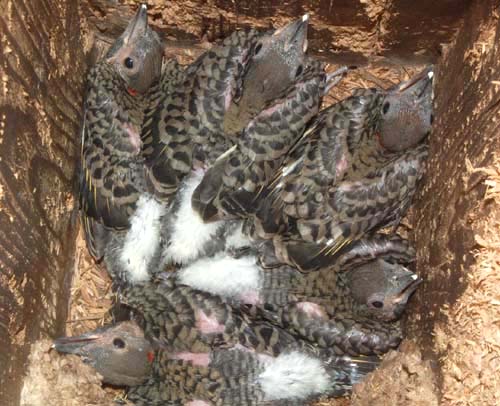 |
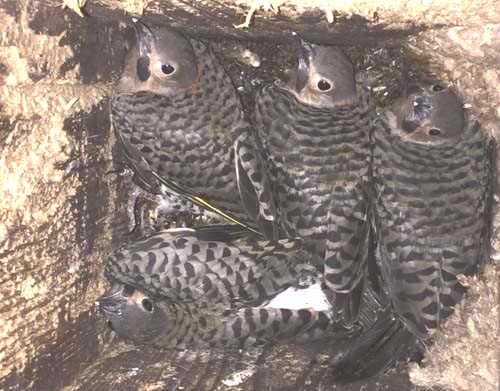 |
| 2022 Flicker Nesting |
|
| This year the flickers once again resorted to using the post mounted nest box beside the barn rather than one of the four boxes mounted on the barn walls. Even though I kept removing starling nests from these boxes, the starlings were persistent in claiming all the boxes except the post mounted one. Squirrels had once again raised a litter in this box over winter, but that had not been a problem for the flickers in previous years. |
 |
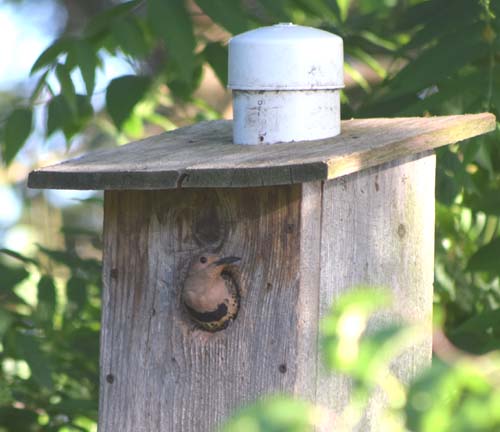 |
|
Male flicker in box entrance
|
Female flicker in box entrance
|
 |
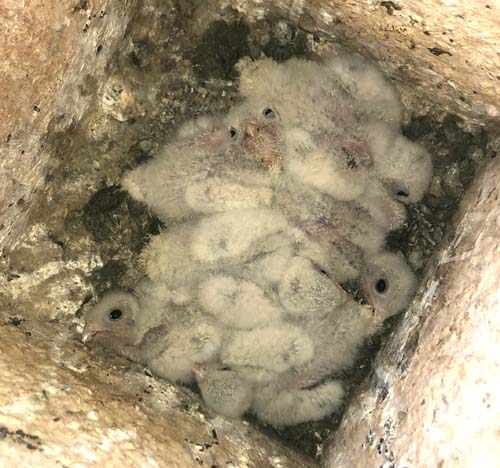 |
|
8 eggs, 6 of which were viable.
|
Six nestlings
|
All was going well with this nesting until one morning when I noticed that the pvc cap had been pulled, or more likely pushed out of the box lid. In approaching the box I saw an intact wing of an adult flicker on the ground. The six nestlings were gone and many adult flicker feathers were scattered on the floor. I assumed that the male had been trapped in the box at night, but soon found that he was very much alive and very upset. He was already hammering and calling, apparently in an attempt to attract a new mate. He kept this up for several days but there was no subsequent nesting.
What predator would be small enough to enter the nest box entrance or smart and agile enough to remove the tight fitting 4” pvc tube from the box lid? My guess is that the creature entered through the box entrance and that the pvc tube was pushed out during the mortal combat that ensued. And who could butcher the female flicker, leaving only one intact wing? Perhaps a squirrel or black rat snake entered and injured the female kestrel who could not fly and was then found on the ground by a larger predator who could butcher and consume the injured flicker. |
 |
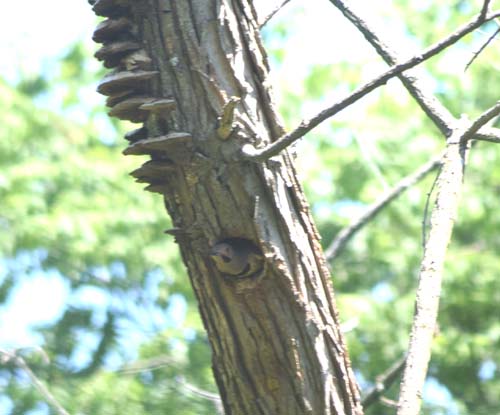 |
|
Predated flicker nest
|
Flicker nest in old snag
|
| The good news is that a second pair of flickers were simultaneously nesting in a small snag along Cattail Branch. I had first observed a pair of bluebirds perched on a branch of this snag last May. The male then entered the cavity. As soon as he exited the cavity, the female entered. This snag is no more than 200 yards from the creek meadow bluebird box where five nestlings were about to fledge. This may be the same pair deciding where to have their second brood. But, a male flicker had other plans. Several days later the flickers had begun nesting in the snag. |
 |
 |
|
Male flicker in snag cavity
|
Hungry nestling flicker
|
| We have lost many coveted snags this past two years, often due to stream bank erosion from frequent floods. But, there are other trees ready to take their place. Downy, hairy, red bellied and pileated woodpeckers all enjoy finding snacks in these snags daily. The pileateds have not nested here yet, but they will. |
| |
|














